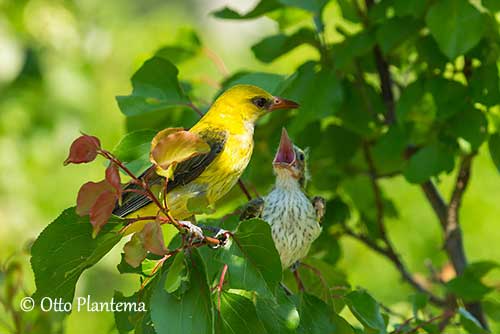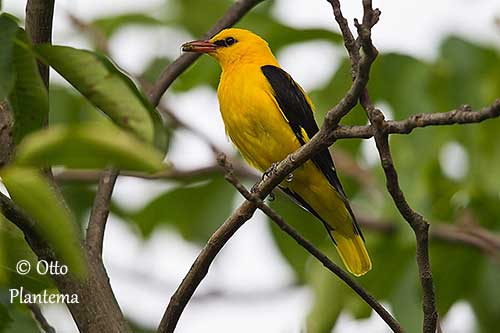
Fr: Loriot d’Europe
Ang: Eurasian Golden Oriole
All: Pirol
Esp: Oropéndola Europea
Ita: Rigogolo
Nd: Wielewaal
Sd: Sommargylling
Photographer:
Otto Plantema
Trips around the world
Text by Nicole Bouglouan
Sources:
HANDBOOK OF THE BIRDS OF THE WORLD Vol 13 by Josep del Hoyo-Andrew Elliot-Jordi Sargatal - Lynx Edicions – ISBN: 9788496553453
THE HANDBOOK OF BIRD IDENTIFICATION FOR EUROPE AND THE WESTERN PALEARCTIC by Mark Beaman, Steve Madge - C. Helm - ISBN: 0713639601
L’ENCYCLOPEDIE MONDIALE DES OISEAUX - Dr Christopher M. Perrins - BORDAS - ISBN: 2040185607
LES OISEAUX D’EUROPE ET D’AFRIQUE DU NORD par Hermann Heinzel, Richard Fitter, John Parslow - Delachaux Niestlé - Isbn : 2603014862
ENCYCLOPEDIE DES OISEAUX DE FRANCE ET D’EUROPE – de Peter Hayman et Rob Hume - Flammarion – ISBN : 2082009920
BIRDS OF THE MIDDLE EAST by R.F. Porter, S. Christensen, P Schiermacker-Ansen C.Helm - ISBN: 0713670169
Wikipedia, the free encyclopaedia
FactZoo.com - Fact pages and pictures of curious creatures
Nature Conservation – Conserve Nature to Save Future
Home page
Page Passeriformes Order
Eurasian Golden Oriole
Oriolus oriolus
Passeriformes Order – Oriolidae Family
INTRODUCTION:
The family Oriolidae gathers arboreal, medium-sized birds. Males have bright-coloured plumages, whereas females are duller.
The Eurasian Golden Oriole is a migratory species. It lives all year round in forests, and both male and female spends most of the time perched high in tall trees. They build a beautiful nest with woven grasses, a bowl-shaped structure where the chicks will be reared by both parents.
The Eurasian Golden Oriole is a very nice bird and its song includes fluty, melodious notes.
It is found in temperate regions of the Northern hemisphere in Europe and western Asia, but it winters in C and S Africa.

DESCRIPTION OF THE BIRD:
Biometrics:
Length: 24-25 cm
Wingspan: 44-47 cm
Weight: 65-67 g
The adult male is unmistakable with golden yellow head, upperparts and underparts. The wings are black with broadly yellow-tipped coverts forming a carpal patch on folded wings, and a yellow crescent in flight. The flight-feathers have narrow, pale yellowish tips. In fresh plumage, outer primaries and outer secondaries show pale yellowish edges on outer webs. The tail is black, with outer rectrices broadly tipped yellow on terminal third. On the yellow head, the lores are black.
The bill is dark pink. The eyes are deep maroon or red-brown. Legs and feet are grey-blue.
The adult female has greenish-yellow head, neck, mantle and back, whereas the rump is yellower. She has mostly green to brownish wings. The tail is brownish-black with yellowish tips to outer rectrices.
On the underparts, chin, throat and upper breast are pale grey, mostly yellowish-white on belly. The underparts are streaked dark, most conspicuous on breast. The undertail-coverts are yellow-green.
She has duller bare parts than male, and dark lores too, but paler than in male. Older females are more similar to males, although duller yellow with indistinct streaking on the underparts.
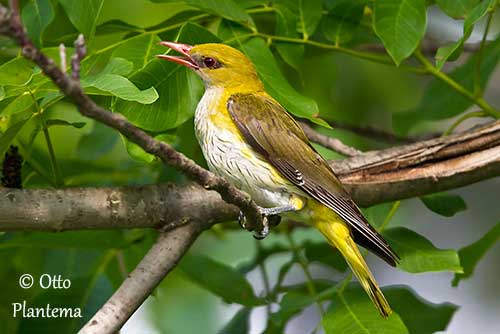
The juvenile resembles female with duller upperparts and more streaked underparts.

RANGE:
The Eurasian Golden Oriole breeds in W, C and S Europe (S from S Finland) and N Africa, E to Altai Mts (S Siberia and extreme NW China) and to N Iran.
It spends the winter in C and S Africa.
HABITAT:
The Eurasian Golden Oriole frequents deciduous woodlands (mainly oak, poplar and ash), groves, parks with tall trees and occasionally large gardens. It may frequent orchards too, and it is sometimes considered a pest in E Mediterranean regions.
This species usually occurs below 600 metres of elevation, but depending on the range, it can be seen up to 1800 metres in Morocco, and up to 2000 metres in Russia.
On migration, it frequents drier, more open bush and savannas, oases and isolated fig trees (Ficus).
CALLS AND SONGS: SOUNDS BY XENO-CANTO
The Eurasian Golden Oriole’s alarm call is a hoarse, mewing, Jay-like “kra-eik” also given in aggressive behaviour.
The song is a mellow, flute-like whistle, a yodelling “tjoh-wlee-klee-ooh”. The last note is hollow and descending. We can also hear several harsh calls.
Duets between mates can be heard too, with the female uttering a short song “skweeeeer” while answering to the whistling male’s song.
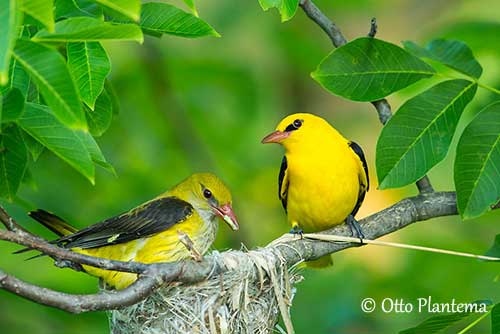
BEHAVIOUR IN THE WILD:
The Eurasian Golden Oriole feeds primarily on insects including caterpillars, but it also takes small vertebrates such as mice, small lizards, nestlings and eggs. It consumes fruits and berries, and occasionally seeds, nectar and pollen.
Insects are mainly taken at the beginning of the breeding season, and also spiders, earthworms, snails and leeches. The diet includes numerous insect species including Odonata, Orthoptera, Isoptera, Cicadidae, Coleoptera, Hymenoptera and several others. Various fruits and berries are mostly taken during the second part of the breeding season.
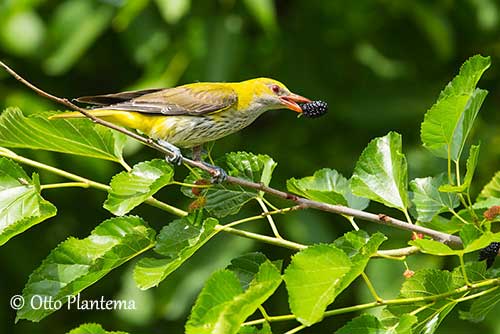
The Eurasian Golden Oriole forages alone or in pairs, and in small groups outside the breeding period. In forages in tree canopy, but groups may gather at fruiting trees (Ficus).
Insects are often caught by flycatching, and earthworms and terrestrial invertebrates are caught on the ground. It sometimes hovers before dropping to the ground in open areas.
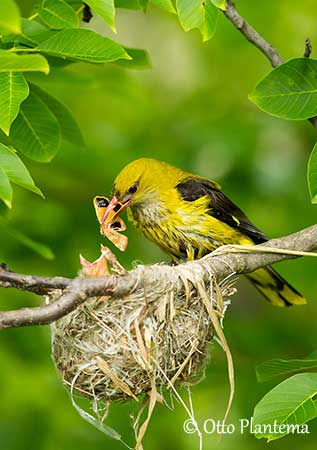
During the breeding season, the Eurasian Golden Oriole male sings loudly at dawn and dusk over its territory. Defence behaviour is also accompanied by calls.
In threat display, it turns from side to side and ruffles the neck feathers while uttering an unusual song, more varied, increasing in volume, speed and intensity.
It adopts aggressive postures with open wings, fanned tail and head stretched forwards, or hovering in front of an intruder. These postures are common in threat displays and accompanied by calls, wing-beating and bill-snapping.
Chases and physical contacts may follow, with sometimes, but rarely, collision in the air or impact with the ground with interlocked feet. These interactions may lead sometimes to injury or death of one bird.
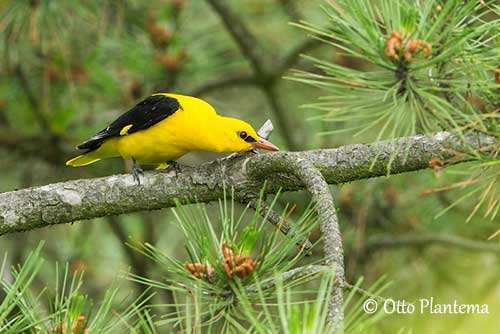
Courtship displays of the Eurasian Golden Oriole consist of calls and aerial chases. The male performs elaborate flight displays with dives, hovering, wing-beating and tail-fanning in view of the female. Chases can be followed by copulation, on branches or on the nest.
The Eurasian Golden Oriole is migratory and migrates mostly at night although they may fly by day too during the spring migration. All populations move southwards. They feed on fruits in E Mediterranean regions, before to reach their African wintering grounds in Sub-Saharan areas. It is a long-distance migrant.
The Eurasian Golden Oriole has fast, gently undulating flight with powerful but irregular wingbeats. While in trees, they fly from treetop to treetop and never stay in the open for long time. They can hover for short periods with fast-beating wings.
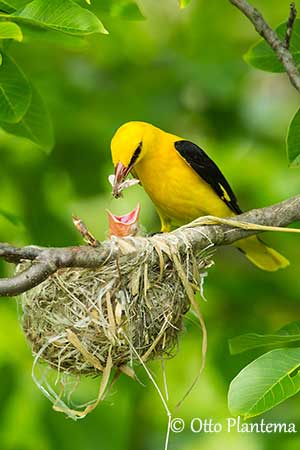
REPRODUCTION OF THIS SECIES:
After courtship displays and chases of intruders and predators, male and female start their breeding season. The nice cup-shaped nest is built mainly by the female during one or two weeks (or more). The male sometimes collects nest materials.
The nest is an open cup-shaped structure made with woven grass, sedges, leaves, twigs or reeds, with in addition string, paper and plastic strips, pieces of bark and vegetal fibres. It is lined with roots and grass, feathers, cobwebs, down, fur, wool, moss and lichens, and sometimes paper. The depth varies from 3 to 13 centimetres.
The nest is suspended in thin, horizontal forked branches, usually high in the foliage of the canopy. It is often near water.
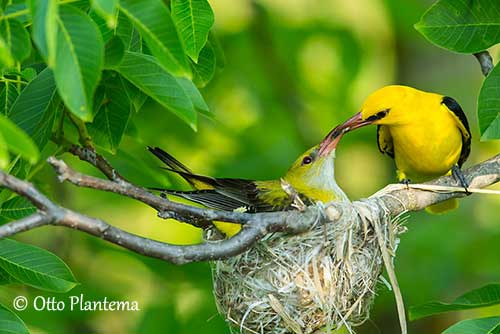
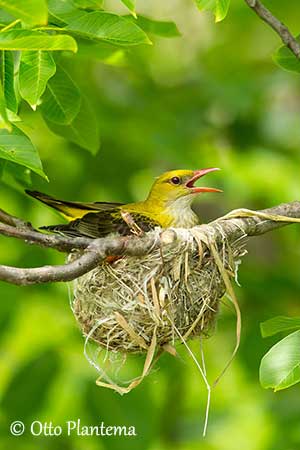
The female lays 2-6 white eggs with scattered dark spots in May/June, or early July. Both adults incubate, but mainly the female, during about two weeks. The male may feed the female on the nest.
At hatching, the chicks are brooded by the female but both parents feed them with invertebrates, and later with berries and fruits. They are able to fly about 14 days after hatching, and they fledge at 16-17 days of age. They still depend on parents for food until August/September, prior to the migration. They can breed at 2-3 years.
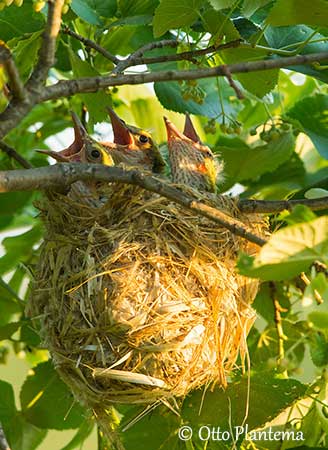
PROTECTION / THREATS / STATUS:
The Eurasian Golden Oriole has wide range and occurs in numerous protected areas in both breeding and non-breeding range.
The European breeding population is estimated to number 3,400,000/7,100,000 breeding pairs (BirdLife International 2004).
Europe forms 25-49% of the total range, and the global population is estimated at 20,800,000/85,200,000 individuals. This population seems to be stable and currently, the Eurasian Golden Oriole is evaluated as Least Concern.
